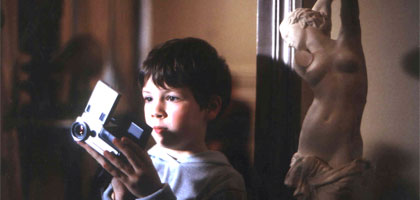
Child's Play
Film of the Month: Comédie de L'innocence

Paul Julian Smith on Raoul Ruiz's chilling tale of child doubles and mad mothers
If Raoul Ruiz is an acquired taste, British filmgoers have had little chance to satisfy their appetite. Surely the most prolific of European auteurs, Ruiz, a Chilean exile long resident in France, has made as many as three films a year. The radical Ruiz, revealed to us in such fanciful features as Les Trois Couronnes du matelot (1983) and La Ville des pirates (1983), was instantly recognisable by his jumbled-up narratives, virtuoso camerawork and playful reflexivity. Ruiz's practice of cinema has tended to be an allegory of art itself, referring to painting (L'Hypothèse du tableau volé, 1978) or baroque Spanish drama (the idiosyncratic adaptation of Calderón's Life Is a Dream, 1987). Even the more mainstream Time Regained (1999) retained some bizarre elements, with Ruiz's focus on the last of Proust's volumes mystifying many who had not slogged through the first 3,000 pages. And his white-faced ghouls and see-sawing seats remained unsettling, even among the reassuring period mise en scène.
In this context, Comédie de l'innocence is Ruiz lite. The narrative is conventional enough, albeit within the genre of the fantastic. At his ninth birthday party Camille (Nils Hugon), a preternaturally intelligent child with a video camera, rejects his natural mother, cool bourgeois Ariane (Isabelle Huppert), claiming to be Paul, the dead son of emotionally unstable music teacher Isabella (Jeanne Balibar). Isabella proves only too willing to accept Camille as her own. How can Camille know so much about this other mother, this other life? Can he truly be Paul reincarnated? Atypically for Ruiz, the narrative is plausibly resolved by the end. And if the plot is strangely traditional, then the shooting style is conventional too. Significantly, however, Ruiz generally avoids a shot-reverse-shot set-up when filming the two mothers together, choosing rather to encircle them with fluid tracking shots.
The film hinges, however, on Camille's video tapes, a typical example of Ruiz's reflexivity. And in this Gallic twilight zone, Ruiz convincingly recreates a tale of the fantastic. The bad seed Camille follows Freud's recipe for the 'family romance', exchanging his real relations for a more exotic parent. And the idea of the double is central to Freud's notion of the uncanny. Ruiz also appears to evoke elements of the fantastic as laid down by the structuralist Todorov: there is a logical contradiction (how can one child have two mothers?); a fundamental uncertainty (is the child innocent or depraved?); and a subjective point of view (can we believe what we see through Camille's viewfinder?). The pixellated video sequences, vividly coloured and jerkily shot, contrast heavily with Ruiz's new-found formal sobriety. Camille seems to embody the radical film-maker that Ruiz, setting sail for the mainstream, no longer cares to be.
After Calderón and Proust, Comédie de l'innocence is another literary adaptation, this time from the little-known Italian surrealist Massimo Bontempelli. Updated from the last fin de siècle to this more recent time of uncertainty, Comédie de l'innocence's plot is small but perfectly formed. With Aristotelian rigour it moves from the opening conundrum (a child torn between two mothers), through the complication (the confrontation between the mothers and Ariane's brother Serge), to a satisfying conclusion. Ruiz, who takes a co-credit as scriptwriter with Françoise Dumas, keeps up the tension, however, with laconic and enigmatic dialogue. When Ariane visits the empty flat of Isabella, a nosy neighbour remarks: 'I really don't want to know.' Ariane replies: 'There is nothing to know.'
Likewise Ruiz challenges the viewer to find out if there is a hidden secret at all. So the film is full of allegories that are just too tempting. Ariane's house, which has been in the family for generations, has a basement where the old furniture is locked away, the very image of the unconscious. Her name is clearly symbolic: like the mythological Ariadne, she holds the threads that demystify the labyrinth (Serge remarks as much). An 18th-century print of The Judgement of Solomon hangs on the wall. When the camera lingers on it we feel cheated; the allusion to a divided child and maternal rivalry is obvious. But then Serge voices his own discomfort with the picture: it is just 'too pertinent' to the family's own story of a boy torn between two mothers.
This art-history reference is characteristic of the movie's bourgeois setting. The family's huge house is full of neo-classical busts (statues are one of Ruiz's fetishes). And the upper-class milieu is at times strangely reminiscent of Proust, as when dinner is taken by candlelight, with Camille dressed in a sailorsuit. Ariane's cold white statuary is contrasted with Isabella's funky African totems. And her address in the 13th arrondissement (far from Isabella's marginal Belleville) allows for some picturesque locations: the champ de Mars and even the Eiffel Tower. Comédie de l'innocence thus playfully provides that stereotypical Frenchness the British bourgeoisie so loves. Ruiz's new formal sobriety is all of a piece with Huppert's wardrobe: prim funnel-necked sweaters in pretty pastels.
But if the house is too light and airy to strike much of an uncanny note, Ruiz's restlessly prowling camera causes an authentic frisson at least once when, with her child missing, Ariane stalks the empty house preceded by the camera. Vital here is Ruiz's new Dolby sound design which highlights her footsteps (until recently he relied on primitive mono). The lush orchestral soundtrack also underlines, ironically perhaps, the changing mood of the moment.
But Ruiz's main focus is the relationship between the two women. And the contrast between Huppert's trademark reserve and Balibar's vulnerability and volatility is telling. Fresh from The Piano Teacher, Huppert brings a subtext of tortured repression. Straight out of Va savoir, Balibar adds a sense of playfulness to her character's madness. Indeed, when Balibar's compelling Isabella is confined to an asylum, she has some caustic comments on psychiatry. If she must learn about herself, is a 'school for madmen' the best place to do it? And why must she be admitted to the asylum before she can be considered for release from it?
Beyond its formality and sobriety, then, Comédie de l'innocence poses some awkward questions. If the child - who seems wise beyond his years - is an adult (the only film-maker in the film), then the adults are children (both Ariane and Serge react violently when their childhood toys are touched). And as the title has a specific resonance in French (where faire la comédie means to play a part), then a problem remains at the end. Just who is acting and who is innocent: the disturbed child or the (possibly) deranged mothers? If Comédie de l'innocence lacks both the bracing difficulty of Ruiz's experimental works and the lush pleasures of his Proust adaptation, it is still to his credit that, through the brilliant performances he elicits from his two lead actresses, he leaves such questions fully open.
